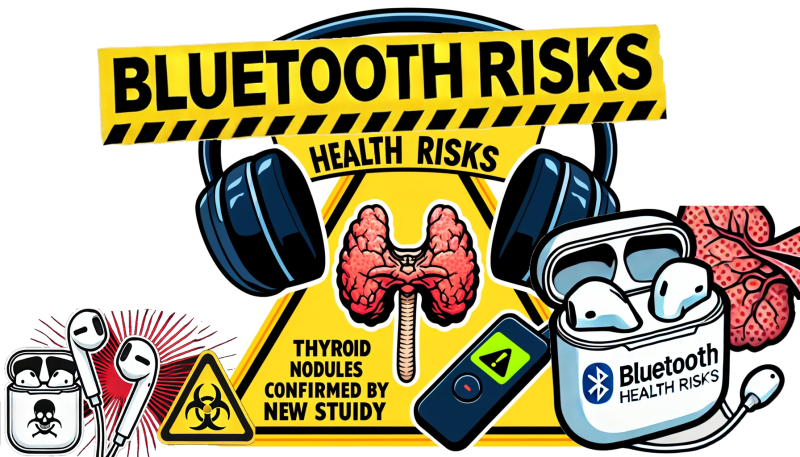A Deep Dive into the Findings and Regulatory Failures

Introduction: Bluetooth Headset Usage and Health Concerns
In recent years, the widespread use of Bluetooth headsets has raised questions about their potential health impacts. A new study titled “Epidemiological exploration of the impact of Bluetooth headset usage on thyroid nodules using Shapley additive explanations method,” published in Scientific Reports, delves into these concerns. This comprehensive study investigates the correlation between prolonged Bluetooth headset usage and the development of thyroid nodules, highlighting significant health risks that demand public attention.
Study Overview: Methodology and Key Findings
Article Open access Published: 21 June 2024
Epidemiological exploration of the impact of bluetooth headset usage on thyroid nodules using Shapley additive explanations method
Nan Zhou, Wei Qin, Jia-Jin Zhang, Yun Wang, Jian-Sheng Wen & Yang Mooi Lim
The PDF document discusses an epidemiological study on the impact of Bluetooth headset usage on the incidence of thyroid nodules. Here are the key points relevant to your concerns:
- Study Purpose and Methodology:
- The study aims to investigate the correlation between Bluetooth headset usage and the development of thyroid nodules.
- Data was collected from 600 valid questionnaires on the WenJuanXing platform.
- Propensity Score Matching (PSM) and XGBOOST model were used for data analysis, with SHAP analysis to identify key risk factors.
- Key Findings:
- The study found that longer daily usage durations of Bluetooth headsets are strongly linked to an increased risk of developing thyroid nodules.
- Age and daily Bluetooth headset usage duration were identified as the most significant factors affecting thyroid nodule risk.
- The AUC value of the XGBOOST model reached 0.95, indicating high accuracy in predicting thyroid nodule risks.
- Discussion:
- The study highlights the potential health impacts of non-ionizing radiation (NIR) emitted by Bluetooth headsets.
- It emphasizes the importance of considering health impacts in the use of modern technology, especially for frequently used devices like Bluetooth headsets.
- The findings suggest that prolonged and frequent use of Bluetooth headsets may be associated with an increased risk of developing thyroid nodules.
- Public Health Implications:
- The study provides a scientific basis for formulating public health policies and personal health guidelines.
- It suggests that attention should be paid to the duration of Bluetooth headset use to reduce the potential risk of thyroid nodules.
- Future research is recommended to further investigate the biological mechanisms of this relationship and consider additional potential influencing factors.
The study’s findings align with growing concerns about the health risks of long-term non-thermal exposure to electromagnetic radiation from wireless devices. The study adds to the body of evidence suggesting potential health risks associated with the use of modern wireless technology, emphasizing the need for updated safety guidelines and further research.
The Alarming Regulatory Landscape: NTP Halts Research Despite Cancer Evidence
The study’s findings are particularly concerning in light of recent developments in regulatory oversight. The U.S. National Toxicology Program (NTP) had previously identified clear evidence of cancer related to cell phone radiation. However, despite these alarming results, the NTP has halted further research on the biological and environmental impacts of cell phone radiofrequency radiation, citing resource constraints and technical challenges. This decision represents a significant abdication of responsibility, leaving the public vulnerable to potential health risks from long-term, non-thermal exposure levels that current guidelines do not adequately address.
FCC’s Outdated Guidelines and Legal Challenges
The Federal Communications Commission (FCC) has also come under fire for its failure to update safety guidelines established over two decades ago. These guidelines, which only consider thermal risks, are woefully inadequate in addressing the broader spectrum of health risks posed by prolonged exposure to non-ionizing radiation from modern wireless devices. In a historic ruling, the United States Court of Appeals for the District of Columbia Circuit found that the FCC’s decision to retain its outdated safety limits was “arbitrary and capricious,” and ordered the commission to explain why it ignored scientific evidence showing harm from wireless radiation.
Comprehensive Research Evidence: A Call for Caution
The Bluetooth headset study adds to a growing body of research indicating potential health risks associated with electromagnetic radiation from wireless devices. Major studies such as the Interphone study, Hardell group studies, CERENAT study, U.S. National Toxicology Program (NTP), Ramazzini Institute Study, REFLEX Project, BioInitiative Report, and the work of researchers like Dr. Henry Lai collectively point towards increased health risks. These findings highlight the urgent need for updated safety guidelines and continued research to protect public health.
Biological Interactions Beyond Thermal Effects: FDA-Approved TheraBionic Treatment
Further complicating the regulatory landscape is the emerging evidence of biological interactions with electromagnetic radiation beyond thermal effects. For example, the FDA-approved TheraBionic treatment, which uses RF radiation at power levels significantly lower than those emitted by cell phones, effectively treats inoperable liver cancer through non-thermal interactions. This underscores the potential for non-thermal effects of RF radiation to influence biological systems, challenging the traditional view that non-ionizing radiation is biologically inert.
The Urgent Need for Updated Guidelines and Continued Research
The new study on Bluetooth headsets and thyroid nodules exemplifies the critical need for updated safety guidelines and continued research into the health impacts of wireless radiation. The cessation of NTP research and the FCC’s failure to update its guidelines represent significant regulatory failures that leave the public at risk. As the use of wireless technology continues to grow, it is imperative that regulatory bodies prioritize public health by addressing the full spectrum of potential risks associated with long-term exposure to non-ionizing radiation.
